Published on May 7, 2013
By Guy Ellis, Guest Contributor
The radar operator on the Bristol Beaufighter, Sergeant Rawnsley, focused on the AI — his only picture of the surrounding skies amidst the darkness of night. Calmly, he called out instructions to his pilot, Squadron Leader John Cunningham, asking for a steady descent toward the target ahead. The Stopley GCI had vectored them in, setting them up perfectly above and behind the German airplane. He felt the plane accelerate slightly as Sqn/Ldr Cunningham carefully edged the control yoke forward to bring the plane’s nose down and edge closer toward the target. If the German bomber didn’t change course, it would soon come into visual range and even now, Cunningham was scanning the skies ahead intently. They would have to ensure that they weren’t overtaking at a too rapid pace or they might end up overrunning the target or worse, even colliding with it.
In the moonlight, they saw the German plane ahead. Sqn/Ldr Cunningham slowed and carefully came up behind. From behind, it looked to be a Heinkel He 111, another night bomber of the Luftwaffe. The Germans were on a course to navigate between Cardiff and Bristol and were heading over the Bristol Channel. Were they going beyond or dropping their bombs one of the nearer cities? It didn’t matter, as the outcome would be the same now. Seeking positive identification, Sqn/Ldr Cunningham began to line up his attack plan.
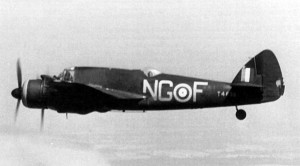
Setting up the Attack
To prevent the Beaufighter from being silhouetted against the glistening, moonlit sea, Cunningham waited for his quarry to be over land. As soon as it crossed the coast and was clear of the Bristol Channel, he moved in. Ahead, the Heinkel’s blue exhaust flames were clearly visible and gave him an ideal focal point for holding formation. With care, he performed his customary identification check. He needed to be absolutely sure of the aircraft type — it would do no good to shoot down another Beaufighter. He knew that such errors could happen easily at night and with the excitement of the chase.
Flying underneath, he looked up at the wing plan form and confirmed his target was a Heinkel He 111 bomber after all. There was no doubt. Never taking his eyes off of the bottom of the enemy plane, he pulled back on the throttles slightly. Slowly, the Beaufighter fell back into trail as he carefully positioned himself for the attack. Night fighter tactics differed sharply from those of the daytime boys in their Spitfires and Hurricanes. They could get into a swirling dogfight, shooting at whatever targets passed before their guns, trying to make sense of the melee, pick a target and attack. In the night, however, it was very different. Stealth, patience and ambush were the best moves. Further, you had to kill from the first shot — usually from so close that you couldn’t miss. If you engaged from farther away, the enemy might be only lightly damaged and thus, he might turn away and flee into the cloaking darkness of midnight. Even with luck, it would be difficult or even impossible to relocate him.
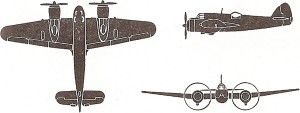
The Attack Begins
Sqn/Ldr Cunningham checked with Sergeant Rawnsley a final time to make sure he was prepared. He reconfirmed too that there were no other aircraft around. Except for the German He 111, they were alone. As described by Sergaent Rawnsley in his later book, “Night Fighter”, the encounter unfolded deliberately and slowly, despite the excitement of finding and engaging a German plane:
“We were right below our target, a great fat prima-donna of a Heinkel. John started pulling up behind it and the long, long wait was even more agonising than usual. But the enemy crew showed no reaction. We were right behind and there came the final moment of tension with the sharp little lurches as John brought the sight to bear. Still there was no response from the Heinkel. Then came the blessed relief of the crash of the guns and the sudden surge upwards to get out of the way of the hurtling wreckage. A wicked orange glow appeared inside the fuselage of the Heinkel and the wheels fell down in the most forlorn way. As we flew alongside, watching, the glow burst through the skin and the flames took over. The whole aircraft trembles and broke into a violent pitching and with a plume of flames streaming out behind it, the Heinkel went down in a headlong plunge to earth.”

From the German Side
From the first sounds of the bullets impacting into his Heinkel, Pilot Oberfeldwebel Heinz Laschinski was in shock. Moments earlier, he had been transferring fuel from the outer wing tanks to the inner ones, unsuspecting that the British airplane was already upon them. When he heard a rattling of gunfire, he saw his observer, Heinz Schier, collapse next to him, obviously dead. Seconds later, fuel spilled onto the cockpit floor. In an instant, it ignited and the cockpit was engulfed in flames. He shouted to the two other crew to bale out as he reached through the flames to grab the handles of his own escape hatch. There was no saving the plane. It was just a matter of survival — to get out before the plane exploded or he was burned alive.
He grasped the handles of the escape hatch and felt a stabbing pain. Blinking through the fire, he saw his hands melting onto the handles. He withdrew them and for an instant looked at his twisted, ruined fingers, as held them up before his eyes. There was only one way out, however. He reached up again and managed to unclip and slide the escape hatch back, burning his hands yet more. He stood up through the inferno to climb into the cold rushing wind from the speed of the plane as it angled through the dark sky. Even then, he couldn’t free himself. His seat parachute caught on the exit hatch, trapping him half in the cockpit, half out. He couldn’t leap clear. As the flames were roaring at his feet and legs, in a panic he pulled the rip cord.
Whether he blacked out or blocked it out he would never know, but a second later he found himself drifting below the mass of his glowing plane, flaming as it careened onward toward its end. Then his parachute was snapped open and jerked him to a stop. The plane sped off into a fiery descent. Then he passed out once again.
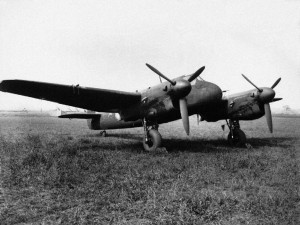
Survivors
Oberfeldwebel Heinz Laschinski came to lying on his back in a damp field. In spite of his very painful burnt hands, he managed to release his parachute. Years later in an interview with author Kenneth Wakefield, he told of how he had walked across a field until he came to a hedge. Then he followed that to a gate. There, he decided to hide his maps and pistol in a drainage pipe. It was pointless to hide himself or try to evade — he was in England, an island nation and his wounds needed immediate care. Through the gate, he walked along a lane to a farm house. It was nearing midnight when he knocked on the door and woke the elderly residents inside. In his best English, he asked them to call the police. He could no longer feel the pain of his burns. Exhausted, he collapsed onto the grass outside to await his fate.
Shortly afterward, the Home Guard, police and some local residents arrived with a number of vehicles. Laschinski’s Heinkel had come down near Weston Zolyand and the closet hospital was at Bridgewater in Somerset. He would be taken there to receive care for his wounds. Once at the hospital, his hands were heavily bandaged. He realized too that his face was badly burned. It would be a long recovery. In later years he remembered with gratitude the excellent treatment he received — even in wartime, the English provided the finest care. He was in turn well liked at Bridgewater and at the RAF hospital at Locking in Weston Super Mare to which he was transferred a month later on June 10, 1941.
Life as a POW
When he had recovered sufficiently to be discharged, he was sent first to the POW staging area at Swindon. From there, he was sent onward to a POW camp at Bury in Lancashire. Kindly, the British had told him that two of his crew members had been found alive near the wreckage of his Heinkel, but it was only when he met up with his wireless operator, Oberfeldwebel Otto Willrich, that he found out more.
What he learned was that when Willrich had heard the order to bale out, he had climbed down into the ventral gunner’s position below the aircraft. There, he had found Fritz Klemm’s body. He had been killed by the guns of the Beaufighter — only one other, not two, had survived. After leaving the aircraft, Willrich landed near a searchlight site between Durston and North Petherton, south of Bridgewater. Almost immediately, he was taken prisoner.
As for their Heinkel He 111P, the aircraft had broken up in mid-air after the two men had escaped. The majority of the wreckage had come down at Andersea Farm in West Zoyland at 11:30 pm.
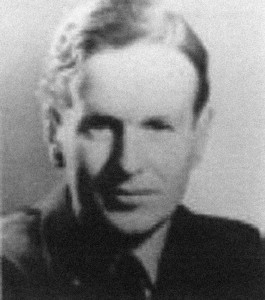
Aftermath
A year later in 1942, Sopley mobile GCI was upgraded with large permanent buildings and the latest radar technology and support systems. For the next 30 years there was continual development including the construction of an underground bunker. Subsequently, in the post-war period, it emerged as a regional control facility. What had started as a handful of mobile, truck-mounted radars, communications vans and control stations had evolved into a full-scale radar base. Decades later, with the centralization of air traffic control, the unit was finally closed. In September 1974, RAF Sopley was handed over to the Army. Later, the site was put up for sale. It was sold and removed from the Army’s installation list in 1993.
As for Heinz Lashinski, he grew a beard to cover his burnt face while he was in the hospitals undergoing burn treatments. After the war, he returned to Germany in 1947 with hopes of returning to flying as a commercial pilot. The long convalescence and the shattered state of the post-war German economy prevented him achieving his ambition, however. Instead, he found employment with the German Post Office. Finally, in the late 1970s, he made plans to visit England and meet the people who had helped and befriended him after he had been shot down. Sadly, just two weeks before his planned visit, he fell ill and died.
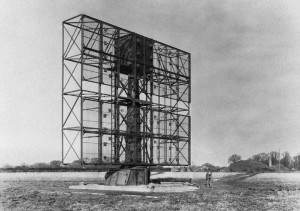
Looking back on the engagement that night — May 7, 1941, which was today in aviation history — the attack and downing of Heinz Lashinski’s Heinkel He 111P was just one in thousands of such stories that combine into the history of the air war in WWII as we know it today. In a sense it was a special event because it was witnessed by the King of England. In another sense, however, it is just another of the many stories of war that are tragic, terrible and rarely glorious, even if often heroic. The scars of conflict are deep and memories are long.
We can only hope that we will never again experience a war of such terrible magnitude. We should give thanks too for what these brave men and women did in those hard years. They gave us the world that we enjoy today — one where we can fly in peace.

In the aftermath section, I was surprised that you did not mention what happened to Squadron Leader John Cunningham.
He became Chief Test Pilot of de Havilland Aircraft. He tested the DH Comet, the first jet transport aircraft to provide jet travel, as well as many other aircraft.
Roy —
Great addition to the story! Thank you for you input and knowledge — as always.
Thomas.
Very well done two part article. We often forget the work the RAF Night Fighters were doing in the 1940-41 time frame, they become overshadowed Churchill’s famous Few. It is also good to hear what it was like to be on the receiving end of such an attack. Keep up the good work.